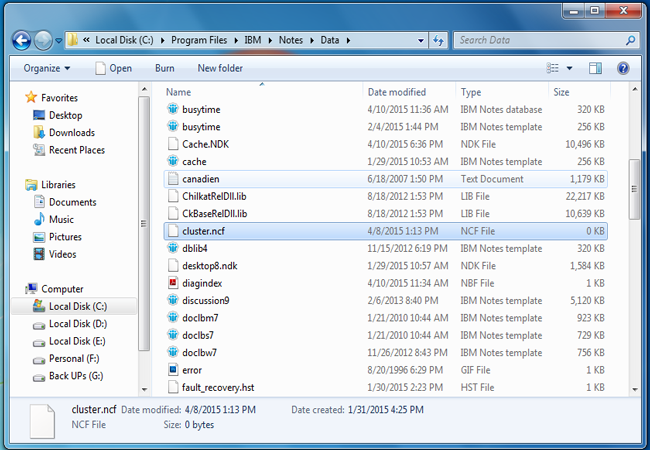|
Cluster.ncf is an important file which is found to be in Notes & Domino data directory and created at the time when it is connected with Domino server. It contains all information of all servers which is available in the cluster. It can contain details about multiple servers in Domino.
Default Location of Lotus Notes Cluster NCF File is: C:\Program Files\IBM\Notes\Data

When the Notes client or a Domino server get connected to a Domino server, that server should be the member of a cluster, then the cluster.ncf file is created even if the cluster or requester are not reside on same domain or Notes Named Network(NNN).
Firstly, the cluster.ncf file is created in a memory cache. Sometimes even after the initial setup for cluster activation, the cluster ncf file is not created until the Lotus Domino server is brought down. When the server or the workstation is stopped, the cluster.ncf get updated on disk in the Notes Data directory.
To troubleshoot the clustering issue and bringing down the Domino server, you will need to create new cluster.ncf file in Lotus clients. To do this, you will have to rename the existing cluster.ncf file and again brought the Domino server back to up. You will not find the newly created cluster.ncf that time. To see the new NCF file, you must have to restart the server again.
Its importance come to know when the IBM Notes 9.0 released. Before the release of the new editions of IBM Notes 9.0, while configuring the Notes Client, a window appears to ask for Domino server name. In case the user forget to provide user name, a message will be displayed “The remote server is not responding...” which creates the difficulty in process of Lotus Notes configuration steps. In such situation user consult to the secondary server name or have to wait for the execution of first server which puts user in trouble in Notes Configuration.
On release of IBM Notes 9.0, this problem overcomed by introducing the cluster.ncf file which instantly provides the server name if the users primary server stopped working. Users of Lotus Notes can be connected to another server by using the details given in cluster.ncf file.
On creating replicas of mail databases in a cluster, the failover occurs in following situation:
Cluster.ncf is an essential for several functions to both the Notes client and the server. This file is also used to determine the connection way for a cluster and also date/time info for each cluster member get updated. This cluster file is used on client to progress the cluster members performance. To determine the routing points for mail failover, cluster.ncf is used on a server. If there is an incorrect cluster.ncf it can results into failover problems.
Apart of resolving all these issues and to wasting your valuable time, you can convert nsf to pst and import pst file in Outlook and access all your mails and other items in MS outlook.